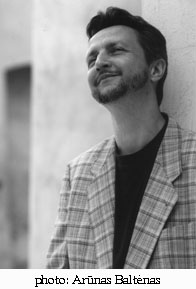 |
The new work by Rytis Mažulis, ajapajapam, awaits its world premiere at the "Gaida" festival by the Latvian Radio Chamber Singers and Chordos String Quartet on Oct. 16. Without hesitation, one could call Rytis Mažulis (b. 1961) one of Lithuania's most consistent composers, for all of his works - from first to last - bear witness to his unshakable devotion to a single technique of composing - i.e., to the canon, adopted from the Renaissance polyphonists. At the same time, this does not restrict his other capabilities vis-à-vis musical expression - not to mention the entire diversity of types and sub-types of canons. Permeating his works are rational constructions of a virtual reality: time dimensions are measured by irrational ratios of polyrhythms, zipped up in polytemporal settings; pitch organization varies from superimposed third structures and tone-semitone-based scales to microtonal depths of a semitone; form dimensions reveal the composer's inclination to compose symmetrical, palindromic structures in the shape of a circle or spiral.
In its aim to achieve a homogeneous sound, the greater majority of Rytis Mažulis' compositions are written for same voice and instrument ensembles - or for electronics, when it becomes impossible to perform them acoustically. In his two latest works, the composer somewhat expands his sound colour palette, while at the same time greatly reducing their sound material. In the 6 minute piece Ex una voce tres for two early instruments and soprano, the entire three-part polytemporal setting is derived canonically from the same interchanging figurations of major and minor triads. And in the over 35 minute long ajapajapam for 12 voices, string quartet and electronics, the point of departure is just the one note.
How did the idea for the ajapajapam piece develop?
The idea to write this piece came up a couple of years ago. The head of the Latvian Radio Choir, Kaspars Putniŋš, who is an old friend of mine, was really taken with the Chordos Quartet, and suggested that I write a work for a chamber line-up of the Choir together with the Quartet.
It used to be said that Mažulis creates one melody, endlessly reproduces it, and thereby composes a large-scale work. This time it's even more impudent: Mažulis has created a single note. I made a terrifically slow single note glissando, gradually expanding into six-part texture and canonically descending a minor sixth. The entire process was created with the help of a computer, and recorded on an electronic track, which is played during the concert. I was especially excited by the fact that in the electronic version there are no note events - only a beginning-accented tone.
Each singer has a click-track and duplicate the pre-recorded pitches with long unaccented notes, so that it flows like one sound. Also, I thought up a micro-rhythmic structure to their scores, with irrationaly related polytempos forming between the different voices.
What is the relationship between the fairly long duration of your work, and its inner density?
When all six lines are crawling along, they form one large cluster, dominated by minor seconds. They're not stable, but always moving, downward changing relationships in pitch. The whole enjoyment of the piece arises from the acoustic processes, for every sound gives its own spectrum, and these constantly change and fight amongst themselves (a fusion-heterodyning effect). In an acoustic sense, there are a great many micro-events in my piece, but the fact that it is made up of a single note, is still a radical limitation. At the same time, this music is full of coincidences, which even I don't fully understand. Suddenly, there seem to appear some sort of little phases, waves, overtones and undertones, secret rhythms recur... Four strings playing sixteenth notes at different tempos also emphasize the so-called overtones with buzzing harmonics.
Is collaboration with the performers important to you, or do you treat them like Stravinsky used to - simply as non-beings, as precise conveyors of musical ideas?
I usually choose the second variant. It's as if, despite myself, I write very radically and shamelessly. I'm in agony when the performers can't play or sing something, but can do nothing about it. Although in ajapajapam I probably came the closest to collaboration, the singers have to decide for themselves how to sing out the sustained notes. But still, I imagine them as if dead, frozen eternally in a static position, with their mouths always agape.
Have you envisaged the same sort of ideal position or environment for your music to be understood?
I think that the reaction of the listeners should be one of immersion, like in meditative music. Which is the reason for the title: here, ajapajapam - "mantra without mantra" - became as if music without music. But I imagine it being performed at the Philharmonic, and I get scared, for people expect sonatas to be played there. For my piece, the performers should sit in a circle, as if carrying out some sort of ritual. It's a very concentrated action, but at the same time, it's not an installation. People can't just wander about, there have to be certain limitations as in concert situation.
© Veronika Janatjeva
Lithuanian Music Link No. 5

